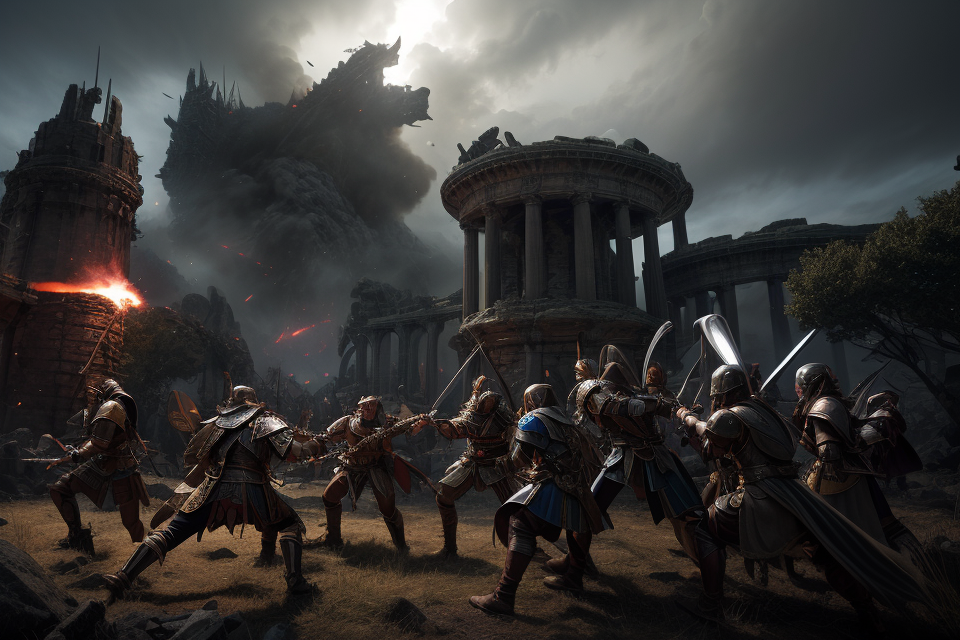In the fast-paced world of Dungeons and Dragons (D&D), time is of the essence. One of the most important aspects of D&D combat is understanding how time works, and how many rounds make up a minute. This question is often asked by players and DMs alike, as it can have a significant impact on gameplay. In this article, we will explore the mechanics of time in D&D combat, and provide a clear answer to the question: how many rounds make up a minute? Whether you’re a seasoned player or just starting out, this article will provide valuable insights into the workings of D&D combat. So, let’s dive in and discover the secrets of time in the world of D&D!
In D&D combat, one round is typically 6 seconds long, and there are 60 seconds in a minute. Therefore, 10 rounds make up a minute of combat. However, it’s important to note that this is just a guideline and can vary depending on the DM’s discretion and the pace of the game.
Understanding the Concept of Rounds in D&D
What are rounds in D&D?
In Dungeons & Dragons (D&D), a round is a unit of time used to measure the progress of combat encounters. It represents a brief period of time during which characters can take actions and monitor their surroundings. The duration of a round is typically six seconds in the real world, but it is important to note that this time frame is not strictly enforced in the game. Instead, it serves as a general guideline for players and Dungeon Masters (DMs) to maintain a consistent pace and keep track of combat encounters.
Each round in D&D is divided into segments called phases, which are used to determine the order in which characters can act. These phases include the initiation phase, where players roll for initiative to determine the order of combat, and the combat phase, where players take turns making attacks, casting spells, and using abilities. Additionally, there are opportunity attacks, which occur when a character moves out of reach of an enemy or otherwise provokes an attack, and reaction attacks, which allow characters to take swift action in response to certain events.
It is important for players and DMs to understand the concept of rounds in D&D as they plan and execute combat encounters. By keeping track of the number of rounds that have passed, players can make informed decisions about when to use their abilities and when to rest and recover. Additionally, DMs can use the concept of rounds to create dynamic and engaging combat encounters that challenge players and keep the game moving forward.
How do rounds work in combat?
- During combat, players take turns making actions and casting spells.
- The order of play is determined by initiative, which is a roll made at the start of each combat encounter to determine the order in which creatures act.
- Players and monsters have initiative scores, which are modified by various factors such as Dexterity, Wisdom, and other abilities.
- Each player gets to act once per round.
- The DM (Dungeon Master) controls monsters and other non-player characters.
- The DM may choose to take additional actions in a round if they control a monster or NPC.
- Players can also take opportunity attacks if they are hit by an enemy in melee, but can use certain abilities to avoid them.
- A round represents a period of time in the game world, but the length of a round is not specified in the rules.
- However, the DM can use their discretion to describe the passage of time in the game world during a round.
- In general, a round takes around 1-2 minutes in the game world, but this can vary depending on the pace of the combat encounter.
- Some spells and abilities have durations measured in rounds, such as the duration of a spell or the time it takes for a trap to activate.
- In addition, some monsters have abilities that allow them to take multiple actions in a single round, such as a druid’s Wild Shape ability or a rogue’s Sneak Attack ability.
In summary, rounds in D&D combat represent a period of time in the game world during which players and monsters take turns making actions and casting spells. The length of a round is not specified in the rules, but the DM can use their discretion to describe the passage of time in the game world during a round. Rounds typically last 1-2 minutes in the game world, but can vary depending on the pace of the combat encounter.
Calculating Rounds in a Minute
What is a minute in D&D?
In the world of Dungeons and Dragons (D&D), time is measured differently than in the real world. In D&D, a minute is a unit of time that is equal to 10 rounds. This means that for every 10 rounds of combat, one minute has passed. It is important to understand this concept as it affects the duration of spells and abilities, as well as the pace of combat.
In D&D, time is not always consistent and can be affected by various factors such as magic and the environment. For example, a spell or ability may cause time to pass more quickly or slowly, or the environment may cause time to move at a different pace. Understanding how time works in D&D is crucial for players and dungeon masters alike, as it can have a significant impact on the outcome of combat and the story.
How to calculate rounds in a minute?
Calculating the number of rounds in a minute is a simple arithmetic operation that requires dividing 10 by the number of rounds per minute. This formula allows players to easily determine the number of rounds that occur within a minute of game time.
To further clarify, let’s take the example of a combat encounter where each round represents 6 seconds of real-world time. In this case, there would be 10 rounds in 60 seconds, or 1 minute, of game time.
It’s important to note that the number of rounds per minute can vary depending on the specific ruleset being used in the game. For example, some games may use a system where each round represents 5 seconds of real-world time, while others may use a system where each round represents 10 seconds of real-world time. In these cases, the formula for calculating rounds in a minute would be different.
Overall, understanding how to calculate rounds in a minute is crucial for players who want to effectively manage their actions and movements during combat encounters in D&D and other tabletop games.
Importance of Knowing Round Durations
Why is it important to know the duration of rounds?
Knowing the duration of rounds is crucial for players to make informed decisions during combat. In Dungeons and Dragons (D&D), rounds represent a set period of time during which players take turns making actions. Each round lasts for about 6 seconds in the game, and there are typically 6 rounds in a minute.
One reason why it’s important to know the duration of rounds is that it allows players to plan their actions strategically. For example, if a player knows that a spell or ability they want to use lasts for multiple rounds, they can time their actions accordingly to make the most of the spell’s effects. Knowing the duration of rounds can also help players decide whether to use a more powerful ability that may require multiple rounds to cast, or whether to save it for a later round when it may be more effective.
Another reason why it’s important to know the duration of rounds is that it can help players estimate how long they have before they need to take their next turn. In D&D, players must take their turn within a certain time limit, or they may lose their turn altogether. Knowing the duration of rounds can help players plan their actions so that they don’t run out of time and miss their turn. Additionally, knowing the duration of rounds can help players gauge how much time is left in the round, which can be useful for deciding whether to use a short-term ability or a long-term ability.
Overall, knowing the duration of rounds is crucial for players to make informed decisions during combat. It allows them to plan their actions strategically, estimate how long they have before they need to take their next turn, and make the most of their abilities and spells.
How does knowing the duration of rounds affect gameplay?
- Understanding the duration of rounds in D&D combat is crucial for players to effectively strategize and manage their time.
- By knowing the length of each round, players can plan their actions more efficiently and make the most of their turn.
- Knowing the duration of rounds also allows players to predict their opponents’ movements and react accordingly.
- Keeping track of rounds can help players avoid running out of time before they have completed their objectives.
- For example, a player may need to use a specific spell or ability within a certain time frame, and knowing the duration of rounds can help them ensure they do not miss their window of opportunity.
- Additionally, knowing the duration of rounds can help players gauge how much time has passed since the start of combat, which can be useful for keeping track of their own health and mana levels, as well as their enemies’.
- Ultimately, understanding the duration of rounds is essential for players to make informed decisions and maximize their chances of success in combat.
Common Misconceptions About Rounds
What are some common misconceptions about rounds?
Misconception 1: Rounds are always 6 seconds long
Many players believe that each round in D&D combat lasts exactly 6 seconds. This is not true, as the length of a round is determined by the actions of the players and the DM. A round can last anywhere from 1 to 10 seconds, depending on the circumstances.
Misconception 2: Rounds are always the same length
Another common misconception is that each round is the same length as the previous one. In reality, the length of a round is determined by the speed of the characters and the environment they are in. For example, a character moving quickly may have a shorter round than a character who is standing still.
Misconception 3: Rounds are measured in minutes or hours
Some players may confuse rounds with other units of time, such as minutes or hours. However, rounds are a specific unit of time used in D&D combat, and are not directly related to other time measurements. It’s important to understand the difference between rounds and other units of time in order to properly play the game.
How can players avoid misconceptions about rounds?
Players can ask their DM for clarification if they’re unsure about how rounds work.
One of the most effective ways for players to avoid misconceptions about rounds is to ask their Dungeon Master (DM) for clarification if they’re unsure about how rounds work. The DM is responsible for managing the game and can provide players with a better understanding of how rounds are used in the game.
Players can read the rules carefully and pay attention to how rounds are used in different situations.
Another way for players to avoid misconceptions about rounds is to read the rules carefully and pay attention to how rounds are used in different situations. By understanding the rules and how they are applied in different scenarios, players can avoid confusion and ensure that they are using rounds correctly.
Players can ask other players for advice and guidance if they’re new to the game.
If players are new to the game, they can also ask other players for advice and guidance on how to use rounds correctly. Experienced players can provide valuable insights and help new players understand how rounds work in the game. This can be especially helpful for players who are still learning the rules and mechanics of D&D combat.
FAQs
1. What is a round in D&D combat?
A round in D&D combat is a unit of time used to track the progress of the battle. Each round represents about 6 seconds of real-world time, and during each round, all characters can take one action. The game uses rounds to determine the order of combat and to track the progression of the battle.
2. How many rounds are in a minute in D&D?
In D&D, a minute is divided into 10 rounds. This means that one round in D&D is equivalent to approximately 6 seconds of real-world time. Each round represents a small portion of the battle, and the game uses rounds to determine the order of combat and to track the progression of the battle.
3. Can players take actions during every round in D&D combat?
No, players can only take one action during each round in D&D combat. The game uses rounds to track the progress of the battle and to determine the order of combat. Players must choose their actions carefully, as they only have one opportunity to take an action during each round.
4. How long is a minute in real life?
In real life, a minute is a unit of time that is equal to 60 seconds. This means that one round in D&D combat is equivalent to approximately 6 seconds of real-world time.
5. Can players take actions outside of their turn in D&D combat?
Yes, players can take certain actions outside of their turn in D&D combat. For example, players can use reaction abilities to take actions in response to events that occur during their turn. Additionally, some spells and abilities allow players to take additional actions outside of their turn. However, these actions are limited and typically have specific requirements.









